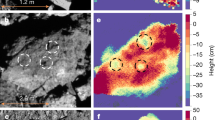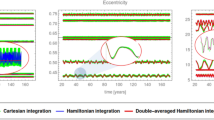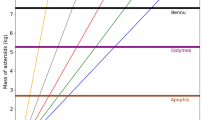Abstract
Light-curve observations have shown that most asteroids are non-axially symmetrical in shape, probably as a result of fragmentation undergone by objects with negligible gravitational binding1. Some earlier laboratory simulations of catastrophic collisions at velocities not exceeding 4 km s−1 (refs 2–4) against cubic and parallelepipedal targets showed that the fragment shapes have a nearly gaussian distribution around the mean value of the axes' ratio 2:√2:1. We report here results from hypervelocity experiments performed at ∼10 km s−1 against free-falling bodies. We found that, regardless of the very different experimental conditions, the shape distribution obtained is closely similar to that obtained2–4 using targets of different shapes and materials and in good agreement with that of the main-belt asteroids of diameter smaller than ∼100 km. This distribution is not consistent with either the symmetrical shapes of the gravity-dominated asteroids, or the elongated Apollo–Amor objects.
This is a preview of subscription content, access via your institution
Access options
Subscribe to this journal
Receive 51 print issues and online access
$199.00 per year
only $3.90 per issue
Buy this article
- Purchase on Springer Link
- Instant access to full article PDF
Prices may be subject to local taxes which are calculated during checkout
Similar content being viewed by others
References
Farinella, P., Paolicchi, P. & Zappala, V. Icarus 52, 409–433 (1982).
Fujiwara, A., Kamimoto, G. & Tsukamoto, A. Nature 272, 602–603 (1978).
Lange, M. A. & Ahrens, T. J. Lunar planet Sci. 13, 417–418 (1982).
Matsui, T., Waza, T., Kani, K. & Suzuki, S. Lunar planet Sci. 13, 475–476 (1982).
Martelli, G. & Newton, G. Nature 269, 478–480 (1977).
Martelli, G. et al. The Comparative Study of the Planets (eds Coradini, A. & Fulchignoni, M.) 333–357 (Reidel, Dordrecht, 1982).
Bianchi, R. et al. Astr. AStrophys (in the press).
Davis, D. R., Chapman, C. R., Greenberg, R. & Weidenschilling, S. J. in Asteroids (ed. Gehrels, T.) 528–557 (University of Arizona Press, Tucson, 1979).
Shoemaker, E. M., Williams, J. G., Helin, E. F. & Wolfe, R. F. in Asteroids (ed. Gehrels, T.) 253–282 (University of Arizona Press, Tucson, 1979).
Author information
Authors and Affiliations
Rights and permissions
About this article
Cite this article
Capaccioni, F., Cerroni, P., Coradini, M. et al. Shapes of asteroids compared with fragments from hypervelocity impact experiments. Nature 308, 832–834 (1984). https://doi.org/10.1038/308832a0
Received:
Accepted:
Issue Date:
DOI: https://doi.org/10.1038/308832a0
This article is cited by
-
The critical state of crushable granular sand
Acta Geotechnica (2024)
-
Three-dimensional shape distribution of lunar regolith particles collected by the Apollo and Luna programs
Earth, Planets and Space (2022)
-
Lightcurve of asteroid Nereus
Earth, Planets and Space (2014)
-
Asteroids: Distributions, morphologies, origins and evolution
Surveys in Geophysics (1992)
Comments
By submitting a comment you agree to abide by our Terms and Community Guidelines. If you find something abusive or that does not comply with our terms or guidelines please flag it as inappropriate.



